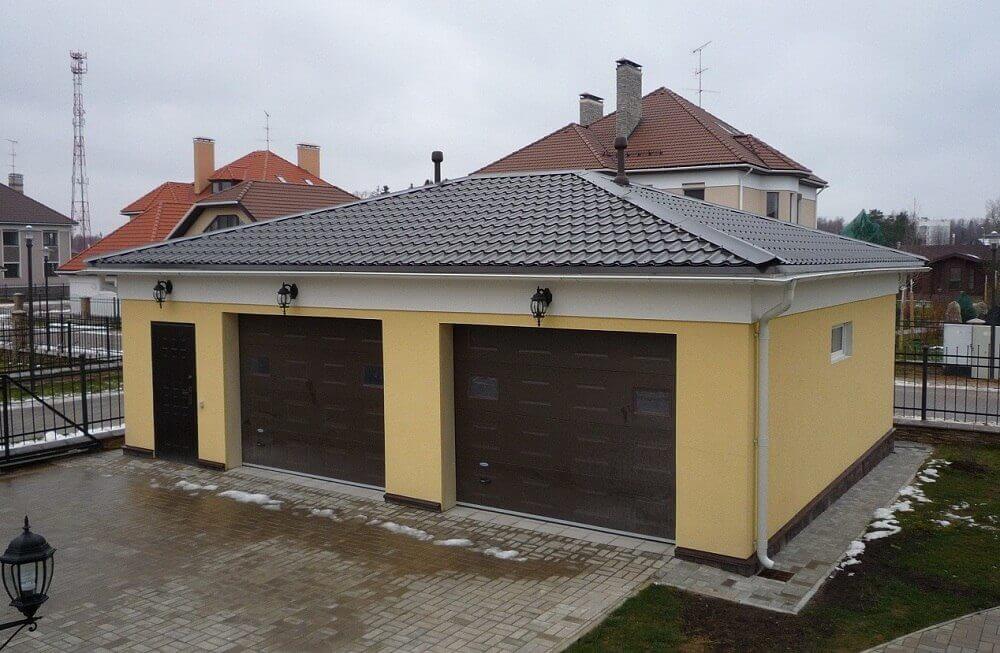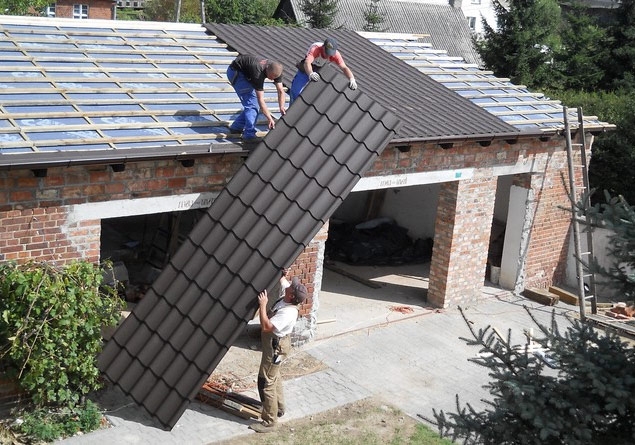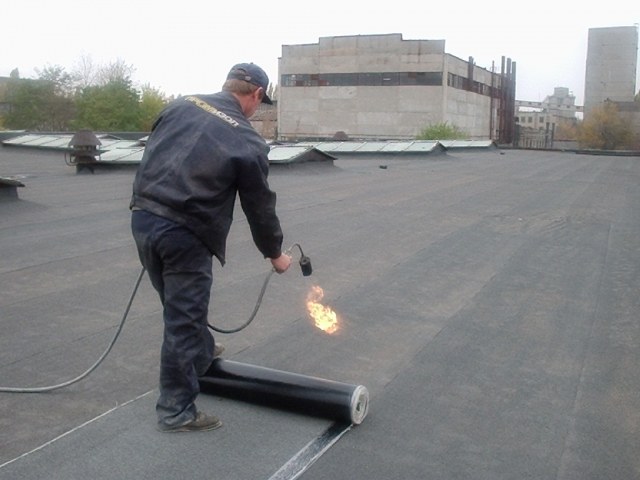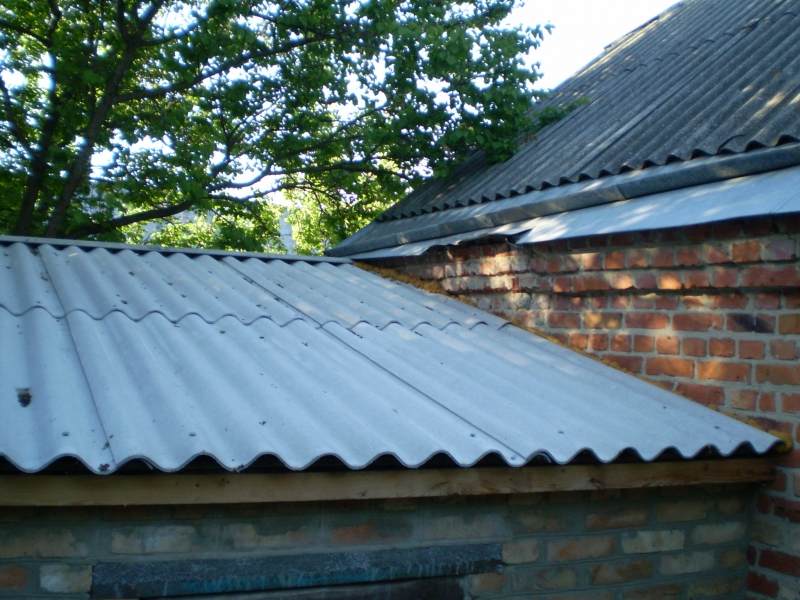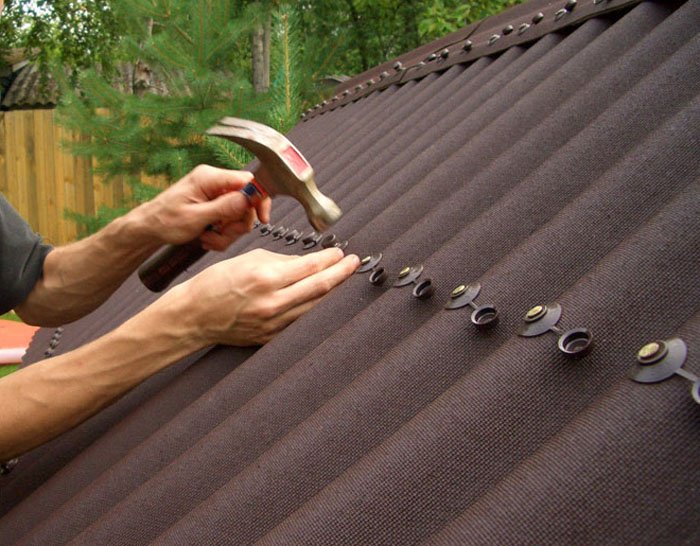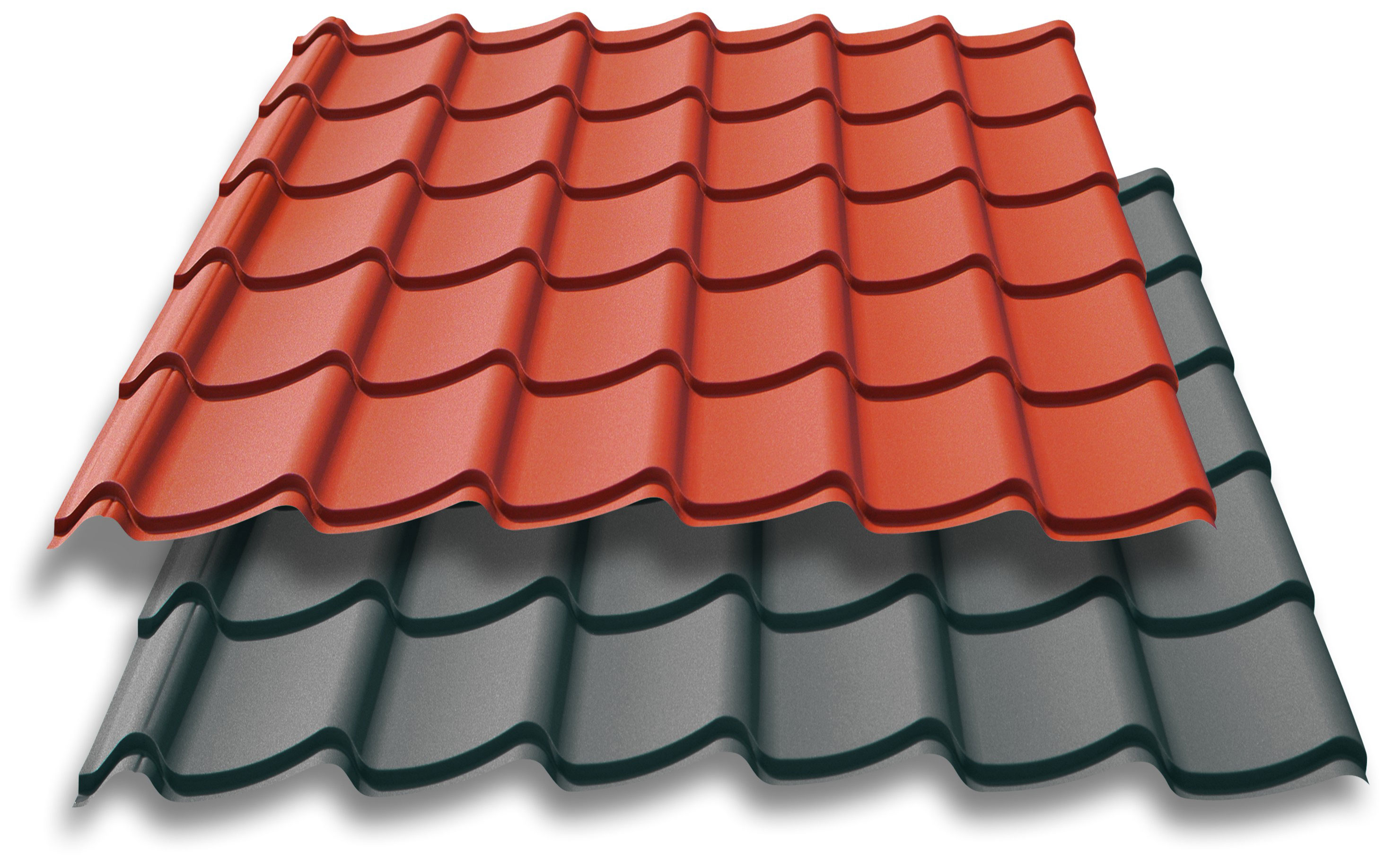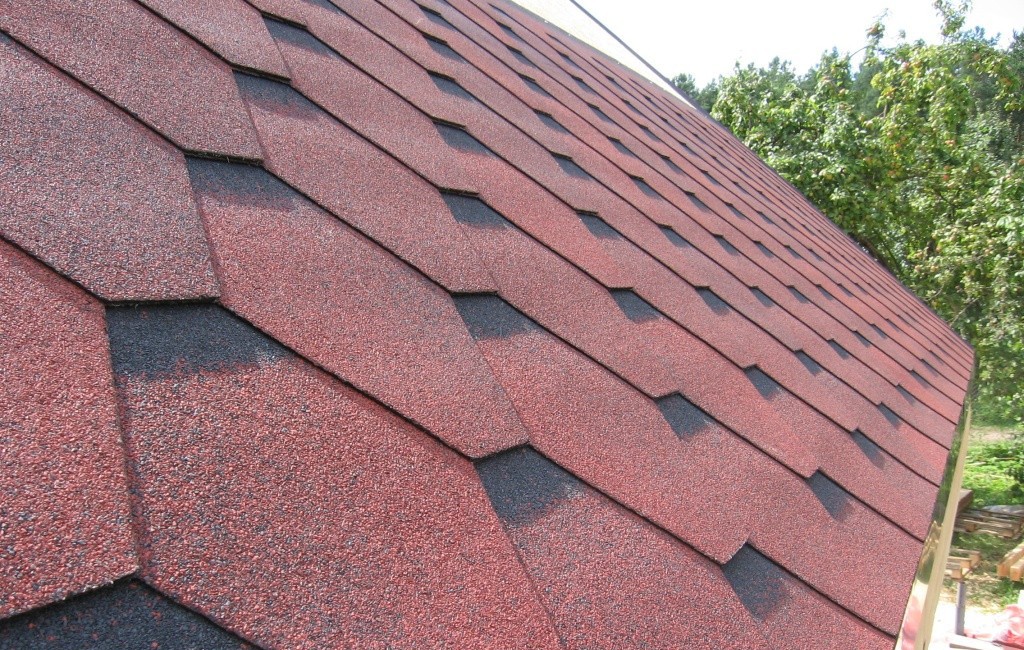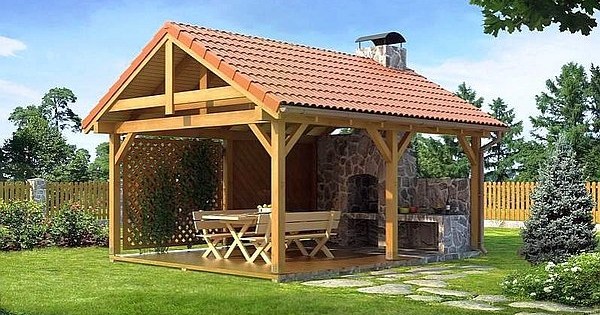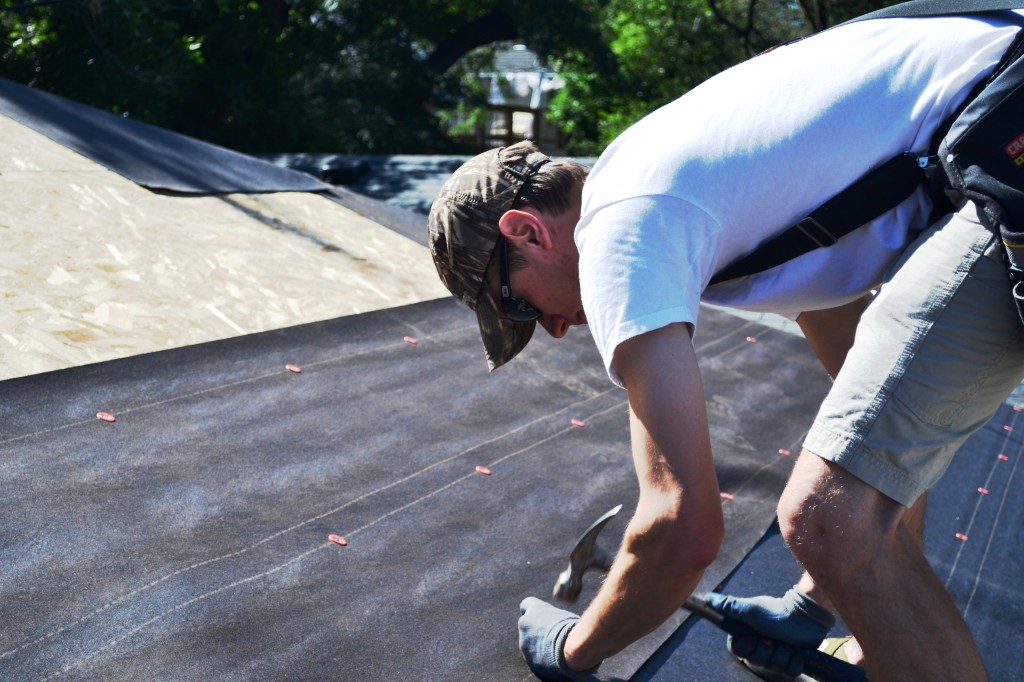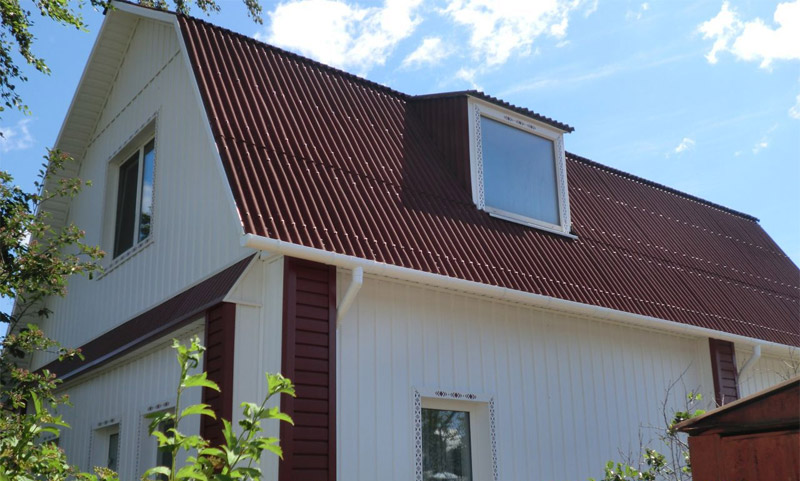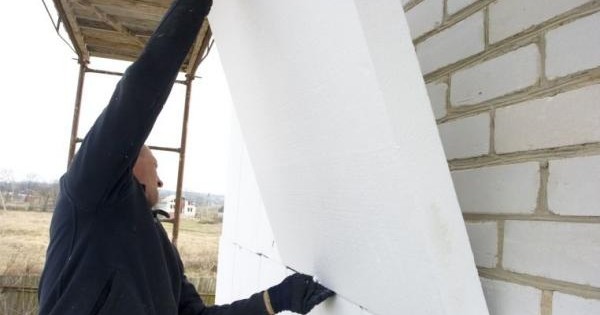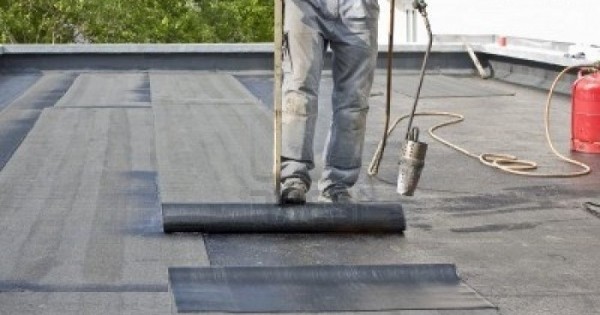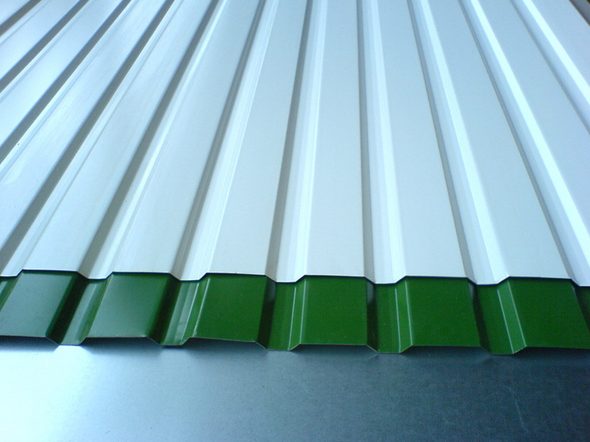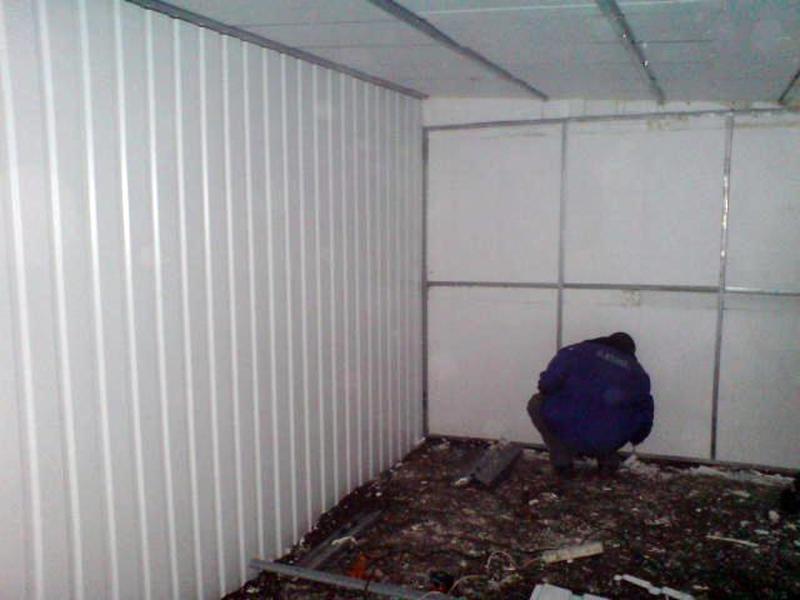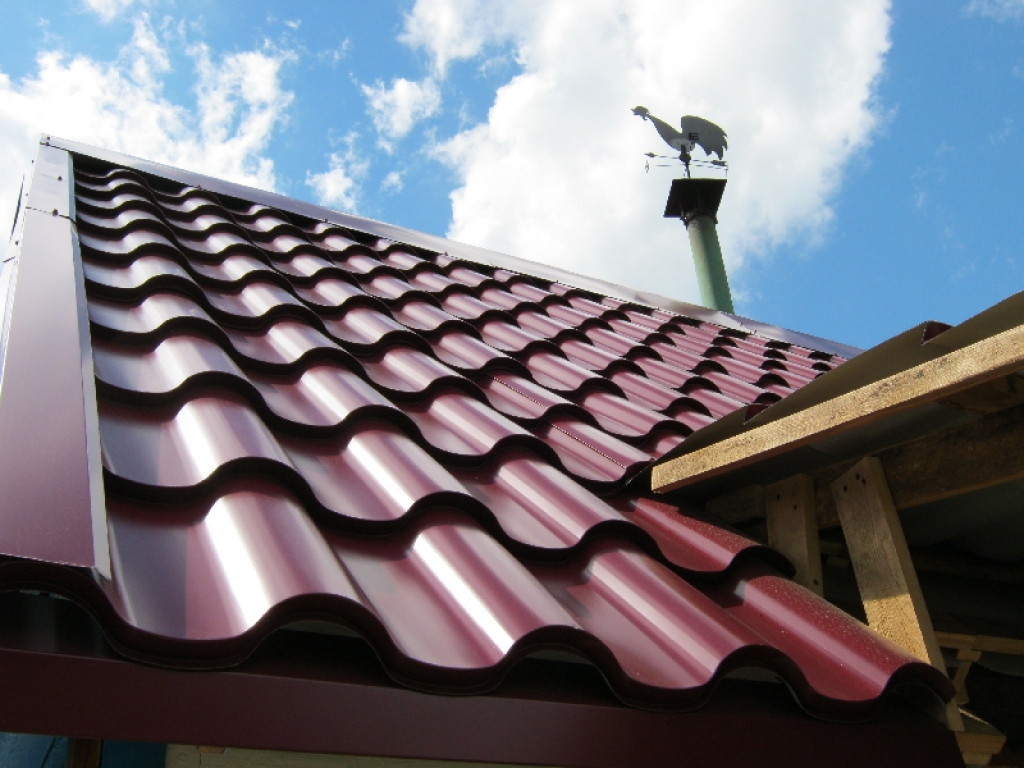How to block the roof of the garage: TOP 8 materials
A garage is a house for a car and often a second house for a car owner, so it must be reliably protected from rain, direct sunlight, temperature extremes and other adverse environmental factors. Almost the most important role in this protection is assigned to the roof, so it is worth approaching the choice of roofing material with all responsibility. It is worth considering not only the properties of the coating, but also its aesthetic qualities, as well as the features of the roof itself. We figure out how to block the roof of the garage, and what material is better to choose in each case.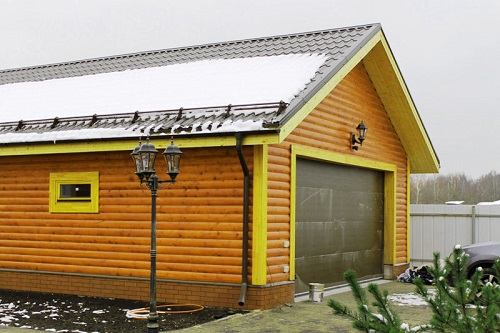
Garage Roofing Requirements
Most car owners, studying the issue of a garage roof, put forward the following requirements to the material:
- reliable protection against precipitation, i.e. the roof must not leak and must withstand the snow load characteristic of the region;
- thermal insulation. The material should at least slightly prevent heat leakage from the room;
- security. The roof should not be vulnerable to thieves;
- aesthetics. If the garage is located next to the house, then it should look attractive. It is desirable that the house, garage and other buildings on the site overlapped with the same material - then the territory will look holistically and stylishly;
- profitability. Well, which of us does not want to save! Of course, between two materials with similar performance characteristics, everyone will choose the one that is cheaper and do the right thing.

Fortunately these requirements suitable mass of materials. They can divided into two types:
- soft. These are all rolled materials, including ruberoid, rubemast, linocrom, bicrost, uniflex, as well as other membrane materials and coatings based on fiberglass. Used to organize almost flat roofs. Materials are notable for their low price and good waterproofing performance, but there are also disadvantages. These are fragility, fire hazard and strong heating in the summer heat;
- solid. Good for gable roofs. The properties are very different. This group includes profile sheets (corrugated board, metal tile), slate, ondulin, concrete slabs.

Type of roof structure
The choice of material for the garage roof depends on many factors. It is worth considering your budget, requirements for the appearance of the coating, as well as installation features. If you are going to carry out roofing work yourself, it is better to choose a material that is easy to install. It is also worth considering the load on the rafter system, foundation, walls. The amendment should be made on the climate in the region, including the strength and direction of the wind, the frequency and intensity of snowfall, the amount of rain. Maintainability of the coating is also important. But above all, it’s worth taking into account type of roof structure:
- pitched roof with a slight slope - the simplest and cheapest option for arranging the roof, it is characterized by relative ease of repair. For such roofs, roll materials (roofing material), as well as sheet materials (metal profile, galvanization) are excellent. When the angle of inclination is less than 15 degrees, do not use slate and ondulin, which can crack, unable to withstand the snow load;
- gable roof can be equipped in almost any way.An exception would be roll materials, which are difficult to weld at an angle of inclination of more than 15 degrees. However, they are used as waterproofing. The best choice will be slate, ondulin, metal and professional sheet. The latter will be a win-win option for areas with harsh winters, because longitudinal ribs provide high resistance to snow loads. Do not forget that the roof, like the walls of the garage, must be insulated. This event will reduce costs for heating and prevent the formation of condensation, which can subsequently drip onto the car;
- three and four pitched roofs they are used extremely rarely, but they look original, all the same materials are suitable for them as for gable roofs. When buying, it is worth taking material with a margin, as there will be more waste with the roof of a more complex structure. The most economical in this case will be metal;
- attic roof differs by an angle of inclination of 45 degrees and more, a broken design. Attic - A great way to complement the garage of the workshop, lounge or even the bathhouse, but the choice of roofing material will have to be approached even more carefully. Slate and thick sheet metal will not work, as they create an increased load on the rafters, so it is better to stop on ondulin, metal tile or professional sheet.
Now, armed with basic information, you can proceed to the analysis of options, how to block the roof of the garage.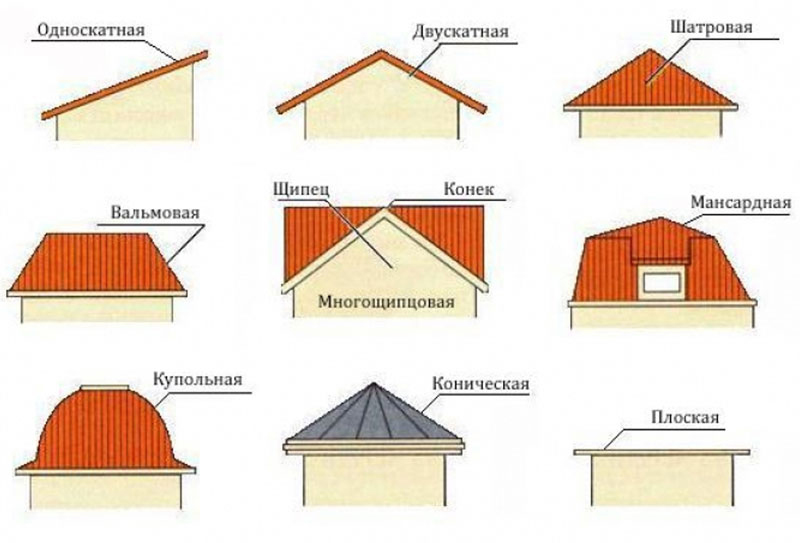
No. 1. Ruberoid
The cheapest way to organize a garage roof. Ruberoid They are produced on the basis of roofing cardboard, which is impregnated with bitumen and protected with asbestos sprinkling, which increases resistance to moisture, sunlight and mechanical stress.
Benefits material:
- cheapness;
- high degree of waterproofing;
- well suited to protect hard to reach places;
- in the presence of special polymer additives, resistance to sunlight and temperature differences increases (these are weaknesses of roofing material).
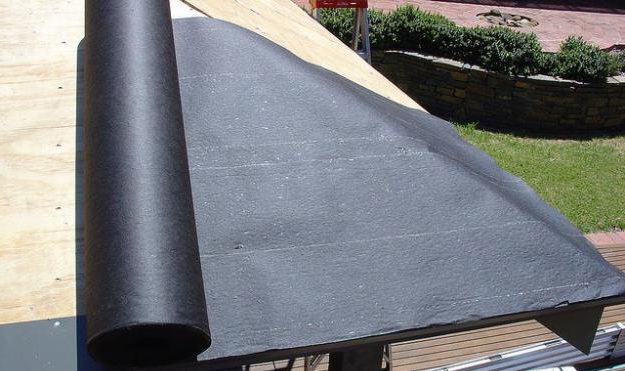 The main limitations:
The main limitations:
- low durability. A few years after installation on the roofing material there will be a lot of cracks, therefore leaks are possible, and there is no need to talk about reliable protection of the garage;
- sensitivity to high temperature (roofing material softens strongly) and low (become brittle);
- fire hazard.
IN new types of roofing material with modifying additives, some of the disadvantages were significantly reduced, because the material is stably in demand. Experts call the roofing material, rather, an option for waterproofing than for covering the roof.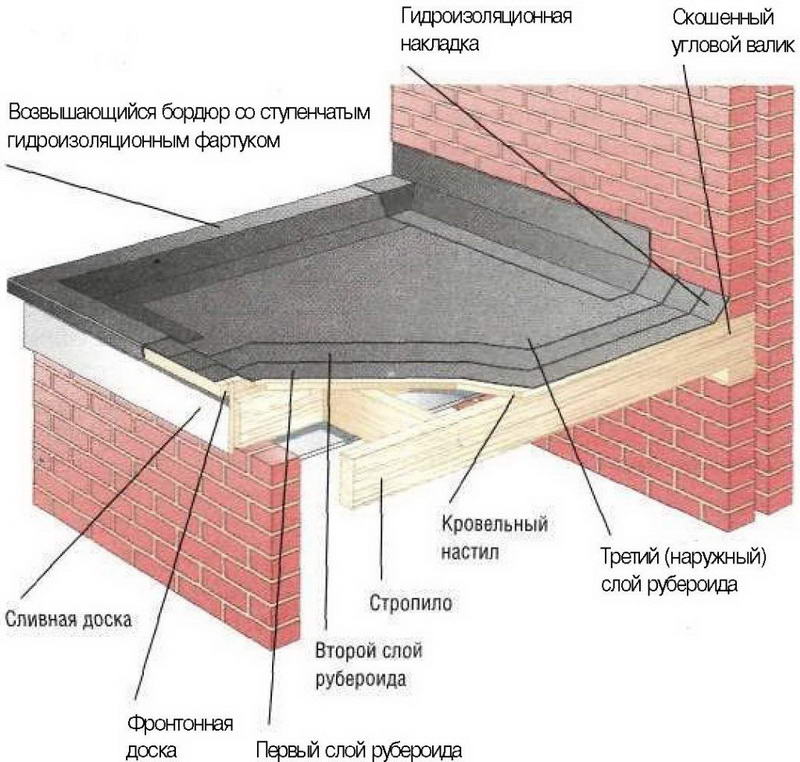
Ruberoid great for pitched, almost flat (slope up to 5 degrees) roofs. On the concrete base of the roof, first perform screed, creating a slight slope for better precipitation. For screed form formwork from boards, concrete better to fill in at once. After 3-4 days, you can remove the formwork, and when the concrete sets well (15-20 days), you can proceed installation of roofing material. In short, the process looks like this:
- the screed is cleaned of debris (notice);
- the screed is covered with bitumen mastic, which will improve waterproofing;
- proceed to the installation of roofing material, which is laid in strips in the direction transverse to the angle of inclination, the base is lubricated with concrete mastic, the bottom layer of bitumen is heated with a gas burner. Overlapping sheets make 10-15 cm, begin installation from the bottom of the roof. After this, the roofing material is mounted in the perpendicular direction, smearing it with bitumen;
- you can lay roofing material in three layers, then the first is done in the direction longitudinal to the roof slope, the second in the transverse, the third again in the longitudinal. The bottom layer can be done not with roofing, but with lining ruberoid.
On sale there is also a self-adhesive and self-leveling ruberoid.
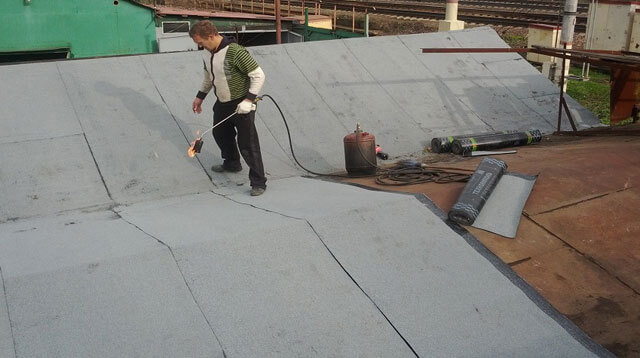
No. 2. Rubemast
it advanced type of roofing material. It is also based on dense cardboard (although fiberglass can be used), which is impregnated with bitumen on both sides. The latter is much larger than in roofing material, which ensures higher ductility, waterproofing and crack resistance. Powder is used for added protection. The bottom layer is a polymer film intended for melting by the burner during installation.
Benefits:
- low price;
- relative ease of installation;
- excellent waterproofing properties;
- resistance to heat, precipitation;
- longevity up to 15 years.

Minuses:
- Does not withstand even small loads. If a person weighing more than 50 kg passes through the coating, then the appearance of cracks is inevitable;
- the base must be level, otherwise cracks may occur during operation;
- under the constant action of direct sunlight after 1.5-2 years, microcracks appear.
Installation can be carried out on bitumen mastic (as in the above-described option for roofing material) or use a gas burner. If the installation work is done correctly, then the problem of the roof leaking in the garage will not affect you for a long time.
No. 3. Linocrome
Linocrome is modern roll material with a base made of fiberglass, which is treated with bitumen and protected with a powder and a polymer film.
Benefits:
- ease of installation;
- resistance to temperature changes;
- low weight;
- maintainability. If any part of the coating is damaged, it is only enough to deposit new material on the desired site;
- tensile strength - the material can withstand significant loads;
- longevity up to 10 years.
disadvantages:
- the top layer is poorly resistant to aggressive substances;
- the material is suitable only for low pitched roofs;
- installation with construction tape is not suitable - the seams in this case will be a weak point.
Installation of linocrom is carried out in dry, calm weather, having previously cleaned the roof surface. The bottom layer is heated with a blowtorch or burner, the material rolls are overlapped.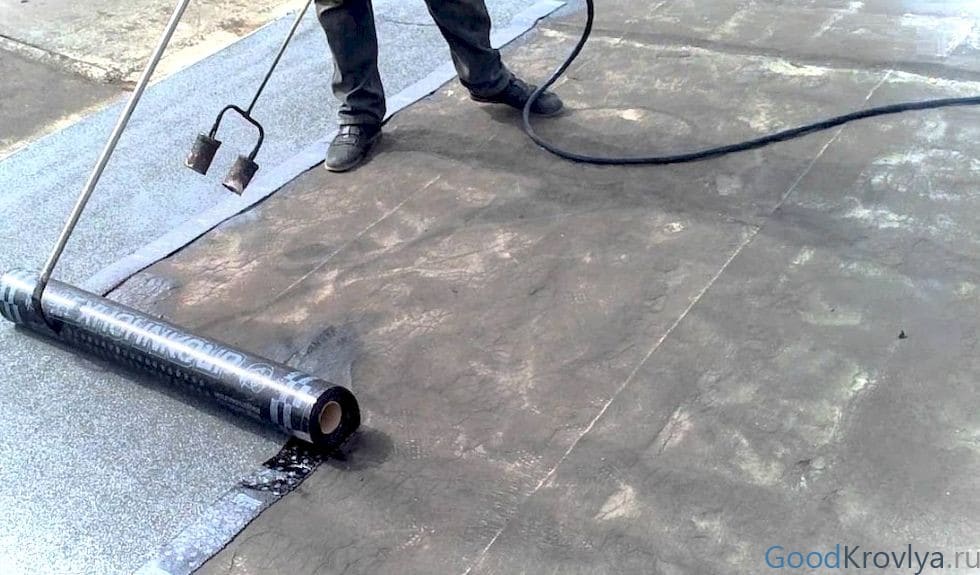
Number 4. Slate
Asbestos cement wave slate - a coating that is familiar to everyone and is widely used in garages. The basis of the material includes Portland cement, asbestos and water, while asbestos plays the role of a reinforcing cage, providing slate with the necessary strength. The typical color is gray, but if desired slate can be painted, increasing its aesthetic appeal and enhancing the level of protection.
Benefits:
- relatively little heat in sunny weather (when compared with roofing material or metal coatings);
- high strength - an adult can walk along the roof without breaking a sheet of slate, which is important if necessary to carry out repair work;
- fire resistance, lack of release of toxic substances during combustion;
- good soundproofing. When it rains heavily, the inside of the garage will be almost quiet;
- resistance to corrosion;
- low price;
- longevity up to 25 years.

It would seem that the ideal roofing material for the garage was found, but there it was. Among The disadvantages of slate are worth noting:
- carcinogenicity of asbestos, which is part of slate, therefore it is better to take chrysolite-cement sheets;
- high weight and brittleness of the material greatly complicate the installation;
- low resistance to temperature extremes;
- under the influence of high temperatures, the slate does not burn, but it cracks with the formation of sparks.
And even despite these shortcomings and the abundance of other materials, slate remains almost the most popular material for a garage roof.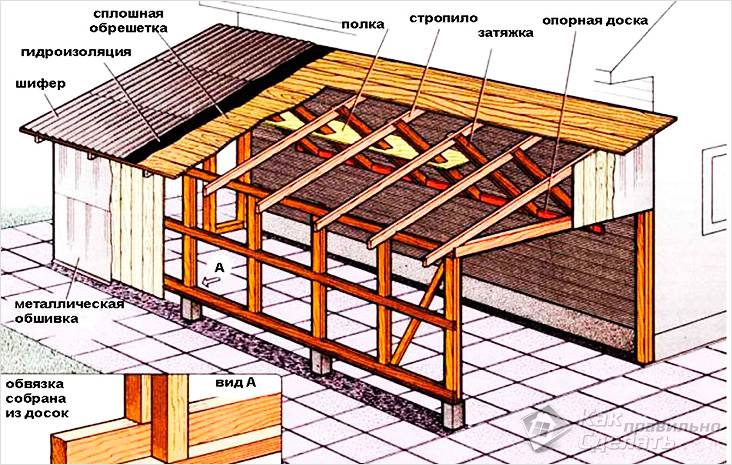
Sheets of slate are placed on the crate, laying one sheet on the other with an overlap of 20 cm. For fasteners are used special nails with an enlarged hat, they are not clogged closely, but leave a gap of 2-3 mm to avoid cracks on the slate. In order not to deform the slate, it is better to pre-drill holes for nails in it.However, it is almost impossible to completely avoid cracks during installation, because at the end of laying the cracks are covered with a solution prepared from cement, PVA glue, asbestos and water in a ratio of 2: 1: 3: 1.
No. 5. Ondulin
Externally ondulin resembles a slate. It is also sold in the form of corrugated sheets, but they are produced on the basis of cellulose fibers, which are mixed with minerals, impregnated with bitumen, resins and special additives. Top (and sometimes top and bottom), ondulin is painted in one of many shades. Due to the impregnation with bitumen and other protective substances, the material obtains a solid resistance to external adverse effects, and the color allows you to get an aesthetic coating, and all this at a relatively low cost.
pros:
- moisture resistance. According to this indicator, ondulin bypasses almost all other roofing materials. Over time, cellulose fibers under the action of sunlight are even more bonded, providing an even higher level of moisture resistance;
- light weight. An ondulin sheet is 4 times lighter than a slate sheet with the same dimensions, therefore it is much easier to transport and assemble material;
- resistance to corrosion;
- soundproofing - the sound of raindrops on the roof will not clog all other sounds in the room;
- ease of processing. With a hacksaw, wood sheets can be easily cut, and thanks to the flexibility of the material, it can be given a complex shape, which will come in handy if the roof has a non-standard shape;
- low cost.

Minuses:
- fading under the influence of sunlight;
- flammability. Already at a temperature of +2500With ondulin begins to burn;
- the appearance of an unpleasant smell in the summer heat;
- fragility at low temperatures;
- low strength is usually associated with a violation of installation technology. If you fasten each sheet with 20 nails and make a crate with a pitch of at least 0.6 m, then you will not have any problems. Nevertheless, in the heat, when the bitumen impregnation softens, it is better not to walk on the roof.
The durability of the material is 15-20 years, subject to proper installation and operation.
Ondulin is attached to the crate of a wooden beam, and the bars should be strictly parallel to each other. Ondulin sheets are most conveniently cut still on the ground. Installation works are carried out at a positive temperature, sheets of ondulin are fixed on special hardware with wide hats.
No. 6. Decking
Another popular option for arranging a garage roof. Decking - This is a sheet of cold rolled steel with a protective coating of zinc, aluminum or polymer. Due to giving the sheet a profile, it is possible to increase its strength properties and at the same time improve the appearance. The profile can be in the form of waves or trapezoids, its height varies from 8 mm to 7.5 cm, for roofing, sheets with a wave height of 35 mm or more are suitable.
Protective covering most often made of polyester, which protects the steel sheet well from corrosion, heat and frost, mechanical damage. Acrylic and PVC coating is cheaper, and in operation it behaves relatively well. Pural (polyurethane with the addition of polyamide and other substances) provides a good level of protection. Zinc coating is the cheapest, applied during the repair and restoration of sheets. For garages near the sea, busy roads or production, you can take a professional sheet with aluminum-zinc coating, and for garages located in the northern regions, with protection from plastisol.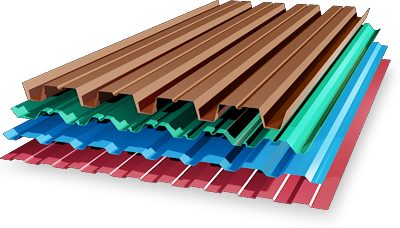
pros:
- low cost;
- relative ease of installation;
- durability up to 50 years;
- resistance to fires, temperature extremes;
- high strength - a sheet of metal can withstand a person walking along the roof;
- corrosion resistance due to the use of protective coatings;
- wide color gamut.
Minuses:
- metal is very hot in the sun, so in the summer it will be in the garage, as in a bath;
- the professional sheet when the raindrops fall is very noisy.
Both of these shortcomings can be minimized if properly performed. heat and sound insulation of the roof.
Installation of a professional sheet it is carried out on a crate of 60 * 40 cm, the bar is pre-treated with an antiseptic. Fasten sheets using special screws with rubber pads. The sheets are laid on top of each other with a slight overlap, in the width of one wave. Between themselves, the profiled sheets are fastened with special rivets in the color of steel, the space between the sheets is filled sealant. Profiled sheets cannot be fixed with ordinary nails - they will come off with a strong gust of wind.
Number 7. Metal tile
Metal tile just like the profiled sheet, it is made of galvanized steel sheet, only they give it not just a wave profile, but imitate the profile of a natural tile. A phosphate layer (additional protection), a primer and a polymer-decorative coating are applied over the protective zinc layer. A protective transparent varnish is applied on the back side. The thicker the sheet, the stronger the coating: for roofing, it is better to take material with a thickness of at least 0.5 mm. Performance is highly dependent on the type of protective polymer coating. Best of all, coating made of pural and plastisol. Matte and glossy polyester is cheaper, but with the installation technique, they are also able to provide reliable protection.
pros:
- light weight, which simplifies installation and reduces the load on the foundation and rafter system;
- resistance to low and high temperatures, high humidity due to the protective coating. It also provides free flow of precipitation from the roof surface;
- relative ease of installation;
- excellent decorative qualities, wide color gamut;
- material does not support combustion;
- relatively low cost.

Minuses:
- loss of a significant portion of performance when the protective coating is damaged;
- difficulties in arranging the roof of a non-standard shape, but garages are usually built with fairly simple roofs, so this minus and minus can not be considered in our case;
- heating in the sun and noise during rain, but with the right sound insulation, this drawback can be easily eliminated.
The metal tile can be used on roofs with an angle of inclination of more than 15 degrees, otherwise, due to the relief of the coating, the snow flow will be complicated. Material is often used when the garage is located on the same site as the house, so that all buildings have the same type of roof.
Number 8. Flexible tile
Flexible tile often call bituminous or soft tileas well as roofing tiles. All these are the names of the same coating, which is produced on the basis of fiberglass. From above, it is covered with a layer of bitumen modified with polymer additives, on top of which a decorative layer with particles of basalt, slate or silicon is applied. Thanks to him, the tile acquires an attractive appearance and receives additional protection from mechanical damage, moisture and sunlight. A self-adhesive bitumen-polymer self-adhesive layer is applied under the glass fiber, which is protected by a film. Soft tiles are sold in the format of small flexible tiles.
pros:
- resistance to moisture, sunlight, temperature extremes and other negative environmental factors;
- ease of installation;
- good indicators of heat and sound insulation;
- durability up to 50 years, and over time, the appearance of the material does not deteriorate, it does not fade in the sun;
- resistance to fire;
- the ability to cover the roof of complex shape;
- great appearance.

Minuses:
- price, so not every car owner agrees to choose this material for roofing in the garage;
- installation can not be carried out at low temperatures;
- since flexible tiles are soft material, it is necessary to build a solid base under it.
Finally, we note that the garage will become a warm and dry place for the car, provided that not only the right choice of material for the roof, but also with its proper installation.If you doubt your own abilities, it is better to invite specialists who can put the selected material correctly.

